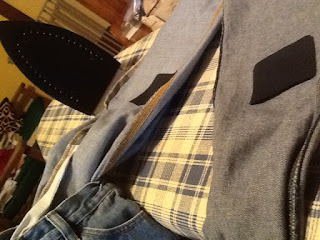Little kid clothing
This week I took one morning off to search for new flannel pjs. Spring's the wrong time of year to look for these, but in Winnipeg, I am just beginning to wear lighter weight clothing...it's finally warming up.
A funny story about clothes you never see: I recently had a spectacular flannel pajama blow out! I had three pairs of serviceable, matching pajamas. (I'm not big on matching at night, I figure who can see the polka dots and stripes and clashing if your eyes are closed?! Answer? Apparently--Your family. The professor bought me these matching pjs as a result!)
Anyhow, it was as if these flannel pajamas all said "We're good for 31 washes. Afterwards? We're done." Within a week, all three pairs of pants ripped across the bottom in a really irreparable kind of way. Rag bag it is, then. I went back to the mis-matched pjs. Loving partner said, "Could you please find new pjs?"
I spent a whole morning traipsing around stores. The good news? I found: 1 pair of cotton flannel pj bottoms, no matching top. 1 box of good British tea that I like. I bumped into one new person I like and talked to her twice. (in two different stores!) I also saw my physiotherapist, who I also like, of course, and met her three year old daughter.
Many things seemed to cost a lot, but weren't made of natural fibres, or made in a sustainable and/or fair trade way. I noticed that a pair of new little boy jeans might cost upwards of $15. (We use a lot of hand me downs and second hand clothes for kids.) I'm beginning to wonder if I have to figure out how to sew pajamas? (in my spare time!?)
I was motivated to go home and fix these two pairs of pants that had been waiting for me. Mending these now has an established process..it takes about an hour. If I fix two pairs, that is well worth the time spent, when you consider how much a new pair might cost.
1) Collect more than one pair of pants with holes to save time.
3. Find fun patches for the right side, and iron those on to cover the actual holes as best you can.
4. These iron-on patches tend to peel off after just one or two wearings--which requires me to take the jeans out of circulation to fix and mend all over again. Now, I just take them right from the ironing board to my sewing kit.
5. I stitch on both patches on the front and the back of the fabric. I've given up making little "hidden" stitches because it is just not worth my time! It's not a secret that I mended this, right? And by the time these bigger stitches rip out, the whole pair of pants will be too small or will have self-destructed somewhere else....
6. At which point it will either find a new home with another kid (if they are still salvageable) or will be used as rags at our house, or will enter the bigger rag trade through a second hand shop my husband has found that will take them.
We tend to wear our clothes hard around here. We fall, dig, play hard, decorate ourselves with chalk and other art supplies--we're busy. Slow fashion seems glamorous when you're talking about buying new, organic, fair trade cotton...whatever, but it's rather less so when it means actually fixing, mending, and making do. However, this is also a bit of a how-to. I've figured it out, know how long it takes now, and find it worth it to do. Not for everything, not those ridiculous pj bottoms (formerly lush, warm, fuzzy cotton flannel), but with no backside left in them!
However, this saves money, saves time (no shopping involved!) and makes two little kids very happy. They get the comfortable, old, worn-in jeans back, but with a novel twist. I get a quiet hour at home instead of a morning driving around to stores which seem to feature mainly throw-away fashion. What's that worth? (Priceless.)
Labels: eco-friendly, green choices, making change, mending, organic, sewing, slow fashion, sustainability, twins, writer's life







0 Comments:
Post a Comment
<< Home